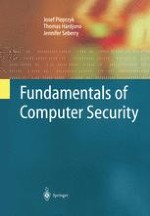2003 | OriginalPaper | Chapter
Access Control
Authors : Prof. Dr. Josef Pieprzyk, Dr. Thomas Hardjono, Prof. Dr. Jennifer Seberry
Published in: Fundamentals of Computer Security
Publisher: Springer Berlin Heidelberg
Included in: Professional Book Archive
Activate our intelligent search to find suitable subject content or patents.
Select sections of text to find matching patents with Artificial Intelligence. powered by
Select sections of text to find additional relevant content using AI-assisted search. powered by
A computing environment can be seen as a collection of resources which are shared by user processes under the watchful eye of the operating system. The collection typically includes hardware resources (the CPU, the main memory, disk space, I/O devices, etc.) and software resources (editors, compilers, debugging tools, etc.). Sharing of resources can take on different forms and each form of sharing requires a different degree of operating system attention or control. For example, resources such as printers may be accessed by every process as long as the operating system puts the interested processes in a queue so they can access the printer sequentially in some order. An editor can be accessed concurrently by many processes as long as each process does not modify it. Normally, personal data files can be accessed by their owners only. The main task of the operating system (OS) is to control the access to system resources. The classification of computer entities into resources (passive) and processes (active) is not disjoint as a process can be also a resource to which another process would like to have access. In the access control vocabulary, passive entities or resources are called objects and active entities or processes are called subjects.
